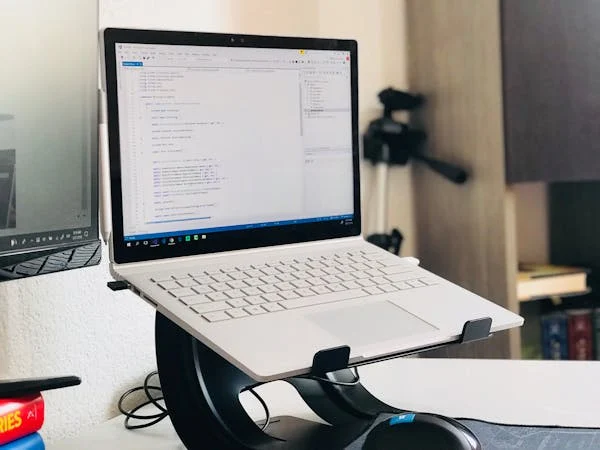The Ultimate Work From Home Ergonomics Checklist: 15 Must-Have Tips for a Healthy Workspace
The Work From Home Ergonomics Essentials
When it comes to creating the perfect work from home setup, ergonomics is crucial. A well-designed ergonomic workspace ensures that you can work efficiently, comfortably, and without the risk of developing long-term physical issues. Let’s break down the key components of a healthy ergonomic workspace—desk and chair selection, monitor placement, and keyboard/mouse ergonomics—so you can make the most of your remote working environment.
Desk and Chair Selection
Your desk and chair are the foundation of your work from home ergonomic setup. Choosing the right furniture is essential for maintaining good posture, minimizing strain on your muscles and joints, and promoting overall comfort during long working hours.
Desk Height Recommendations
- Optimal Elbow Angle: The height of your desk should allow your elbows to rest at a 90-degree angle while typing. This promotes neutral wrist positioning and reduces strain on your arms, wrists, and shoulders. By adjusting the desk height accordingly, you can prevent discomfort in the upper body, which is essential for long periods of sitting.
- Legroom and Movement: Ensure your desk provides enough legroom to allow your legs to move freely. Your thighs should be parallel to the ground, and there should be enough space for your feet to rest flat on the floor or a footrest. Adequate leg space improves circulation and prevents discomfort in your thighs and knees, helping to avoid numbness and stiffness.
Chair Ergonomics Tips
- Support for Your Spine: A key element in work from home ergonomics is the chair’s lumbar support. A chair with lumbar support helps maintain the natural curve of your spine by preventing slouching and reducing pressure on your lower back. Look for a chair that has an adjustable backrest and supports the natural curvature of your spine to prevent back pain.
- Adjustable Height for Comfort: To ensure proper posture, adjust your chair height so that your feet rest flat on the floor. If your feet don’t reach the floor, use a footrest to ensure proper alignment of your knees. Your thighs should be parallel to the floor, and your feet should be comfortably supported. This helps reduce lower back pain and improves blood flow to your legs, which is essential for overall comfort during work hours.
Monitor Placement and Screen Adjustments
Your monitor setup plays a significant role in reducing neck, back, and eye strain. If your screen is poorly positioned, you may find yourself slouching or squinting, which can cause discomfort and fatigue. Proper screen placement ensures that you maintain an optimal posture and helps you stay focused for longer periods.
Ideal Monitor Height
- Eye-Level Positioning: The top of your monitor should be positioned at or slightly below eye level. This allows you to keep your neck and head in a neutral position, preventing neck strain and fatigue. If the monitor is too high or too low, you’ll find yourself constantly tilting your head, leading to discomfort and potential long-term injury.
- Proper Viewing Distance: Place your monitor about 20–28 inches away from your eyes (roughly the length of your arm). This ensures that the screen is within your natural field of vision, reducing eye strain and promoting comfort. You should be able to glance at the screen without squinting or straining your eyes.
Multi-Monitor Setup Tips
- Align Monitors at the Same Height: If you’re using multiple monitors, it’s important to align them side by side and ensure both are at the same height. Misaligned monitors force your neck to tilt constantly, leading to discomfort and potential injuries. Aligning the monitors reduces the strain on your neck and shoulders.
- Position the Primary Monitor in Front: Use the primary monitor directly in front of you for tasks that require focus and concentration. Place secondary monitors to the side for tasks that don’t require as much attention. This setup reduces neck strain by limiting the amount of head turning required. Make sure you don’t have to twist your body to look at either monitor.
Keyboard and Mouse Ergonomics
The position of your keyboard and mouse is just as important as your chair and monitor placement. Incorrect positioning can lead to wrist and shoulder pain, affecting your productivity and well-being. Let’s dive into the best practices for optimal keyboard and mouse ergonomics.

Choosing the Right Keyboard
- Ergonomic Keyboards: One of the best work from home ergonomics investments is an ergonomic keyboard. These are designed with a split keyboard layout that allows your hands to rest in a more natural position, reducing wrist strain. By typing on a keyboard that keeps your wrists straight, you lower your risk of developing repetitive strain injuries such as carpal tunnel syndrome.
- Positioning the Keyboard: Ensure your keyboard is placed at a height that keeps your wrists neutral while typing—neither bent upward nor downward. Your forearms should be parallel to the floor, and your wrists should be aligned with your elbows to avoid strain on the wrists, elbows, and shoulders.
Proper Mouse Usage
- Ergonomically Designed Mouse: Choose a mouse that fits comfortably in your hand, allowing you to hold it naturally. This prevents wrist strain and reduces the risk of developing hand fatigue. An ergonomic mouse allows for a more relaxed grip, which minimizes the stress on your hand and wrist.
- Positioning the Mouse: Keep the mouse close to your keyboard to avoid reaching excessively, which can strain your shoulder and wrist. When the mouse is within easy reach, you can move your hand freely without straining your arm. Try to keep the mouse at the same height as your keyboard to maintain good posture.
Additional Ergonomic Considerations
Beyond the basic essentials of desk, chair, monitor, and keyboard placement, consider other elements that contribute to a healthier work from home experience:
- Lighting: Make sure your workspace is well-lit to prevent eye strain. Position your monitor away from direct light sources to reduce glare. If possible, use natural lighting or task lighting to illuminate your desk without causing strain.
- Breaks and Movement: While ergonomics focuses on the setup of your workspace, it’s also important to take regular breaks. Stand up, stretch, or walk around every 30-60 minutes to reduce the risk of muscle stiffness, fatigue, and joint discomfort.
By incorporating these work from home ergonomics essentials into your daily routine, you’ll create a workspace that not only boosts productivity but also ensures long-term health. From desk and chair selection to proper monitor and keyboard placement, optimizing your workspace will reduce strain on your body and help you maintain comfort throughout the day. Prioritizing ergonomics is not just a short-term solution—it’s a long-term investment in your well-being and remote work success.
Lighting and Eye Care
Proper lighting and eye care are critical components of a work from home ergonomic setup. Inadequate lighting or improper exposure to blue light can lead to eye strain, headaches, and decreased productivity. Let’s explore how lighting affects your work environment and ways to protect your eyes while working remotely.
Natural vs. Artificial Lighting
Lighting plays a significant role in your work from home ergonomics. A well-lit workspace reduces eye strain and helps maintain focus, while improper lighting can cause discomfort and hinder productivity.
Place Your Desk Near a Window
- Maximize Natural Light: Whenever possible, place your desk near a window to take advantage of natural light. Natural sunlight has been shown to improve mood and energy levels, which can help boost productivity during work hours. It also minimizes the need for artificial lighting, creating a more comfortable and productive work environment.
- Avoid Glare: Although natural light is beneficial, direct sunlight can cause glare on your screen, leading to eye strain and discomfort. Position your desk strategically so that the light comes from the side rather than directly in front or behind your screen to avoid glare.
Use Soft, Diffused Lighting
- Reduce Harsh Light: Soft, diffused lighting is ideal for your work from home setup. Harsh, direct lighting can strain your eyes and cause discomfort, especially if you’re working for long hours. Consider using warm LED lights or desk lamps with adjustable brightness to create a cozy and well-lit workspace.
- Avoid Overhead Fluorescents: Overhead fluorescent lighting can often create glare and shadows, leading to visual fatigue. Use desk lamps with diffusers or soft LED lights to ensure the lighting is gentle and evenly distributed.
Blue Light Protection
The increased use of digital devices has raised concerns about the harmful effects of blue light on our eyes. Blue light emitted by screens can cause digital eye strain and disrupt sleep patterns if exposure is too high. Protecting your eyes from blue light is crucial for maintaining comfort and well-being during long hours of remote work.
Enable Blue Light Filters on Your Devices
- Software Solutions: Many devices offer built-in blue light filters that adjust the screen’s color temperature to reduce the emission of blue light. Enabling these filters, especially in the evening, can help reduce eye strain and improve sleep quality.
- Automatic Adjustments: Many operating systems, like Windows and macOS, have features like Night Shift or Night Mode that automatically adjust your screen’s blue light emission based on the time of day. These features are particularly useful for preventing eye discomfort during late-night work sessions.
Invest in Blue Light-Blocking Glasses
- Blue Light Glasses: To further reduce the risk of digital eye strain, consider investing in blue light-blocking glasses. These glasses filter out a portion of blue light, reducing the strain on your eyes and minimizing the risk of headaches or blurred vision. They are particularly useful if you work long hours on screens or if you find that your eyes often feel fatigued after a day of work.
- Anti-Reflective Lenses: If you wear prescription glasses, look for lenses with anti-reflective coatings. These coatings reduce glare and reflections from your screen, improving visual comfort and clarity.
Posture and Movement
Maintaining good posture and incorporating regular movement into your daily routine are essential for work from home ergonomics. Poor posture can lead to a range of issues, from back pain to eye strain, while staying sedentary for long periods can result in stiffness, fatigue, and decreased circulation. Here’s how to improve your work from home ergonomics and ensure you’re moving regularly to stay comfortable and healthy while working remotely.
Correct Sitting Posture
Your posture directly impacts your physical health and comfort. Sitting improperly for long hours can lead to back pain, neck tension, and poor circulation, all of which contribute to a decrease in productivity. Here are some tips to optimize your sitting position for an ergonomic work from home setup.
Sit with Your Back Straight and Shoulders Relaxed
- Maintain Natural Spine Curvature: Ensure your back is straight, and your shoulders are relaxed when sitting. This helps maintain the natural curvature of your spine, preventing strain on your back and neck. Avoid slouching or leaning forward, as it can create additional pressure on the spine, leading to discomfort and long-term health issues.
- Lumbar Support: Your chair should provide adequate lumbar support to maintain the natural curve of your lower back. If your chair lacks lumbar support, consider adding a cushion or using a rolled towel to provide extra support for your lower back. Proper lumbar support helps to prevent musculoskeletal disorders commonly caused by sitting improperly for extended periods.
Feet Flat on the Ground, Knees at a 90-Degree Angle
- Foot Positioning: Keep your feet flat on the ground or on a footrest. Your feet should be comfortably supported, ensuring good circulation and reducing the risk of swelling in your legs.
- Knee Angle: Your knees should form a 90-degree angle when sitting. Your thighs should be parallel to the floor, with your knees at the same height as your hips. This seating position promotes comfort and proper alignment of your legs, reducing pressure on your knees and improving blood circulation. By adhering to work from home ergonomics, you can avoid discomfort and reduce the risk of long-term health issues.
Importance of Regular Breaks
Even with perfect posture, sitting for extended periods can still lead to discomfort and stiffness. Regular breaks are essential for preventing the negative effects of prolonged sitting, such as back pain, muscle stiffness, and eye strain. Let’s look at ways to stay active and comfortable throughout your workday.
Follow the 20-20-20 Rule
- Prevent Eye Strain: One of the most common complaints among remote workers is digital eye strain, often caused by staring at a screen for long periods. To alleviate eye fatigue, follow the 20-20-20 rule: Every 20 minutes, look at something 20 feet away for 20 seconds. This simple technique helps to relax the muscles in your eyes and reduces the risk of eye strain and discomfort.
- Blink More Often: Additionally, remember to blink more frequently while working to keep your eyes moist and avoid dryness. Screen ergonomics also play a role in preventing eye strain—adjust your monitor’s height and distance to ensure a comfortable viewing position.
Incorporate Stretches and Light Movements Every Hour
- Stretching: Set a reminder to stand up, stretch, and move around every hour. Simple stretches for your arms, legs, back, and shoulders can help alleviate tension and prevent stiffness. Stretching improves blood flow and reduces muscle fatigue, making you feel more energized throughout the day.
- Move Your Body: Incorporate light movements like walking around, rotating your shoulders, or gently twisting your torso to relieve tension. Movement encourages better circulation and helps prevent the negative effects of sitting for too long. Even a short walk around your home or a quick 5-minute movement break can make a significant difference in your comfort and focus.
These ergonomic movement tips can help you stay comfortable and healthy throughout your remote workday. By adjusting your sitting posture and integrating regular breaks into your routine, you can significantly improve your overall productivity and well-being.
Ergonomic Accessories for WFH Setup
Creating the ideal work from home ergonomics setup involves more than just a desk and chair. Investing in ergonomic accessories can significantly enhance your comfort and productivity by improving posture, reducing strain, and preventing long-term injuries. Let’s explore some key ergonomic accessories that can elevate your remote workspace.
Footrests and Laptop Stands
Footrests and laptop stands are essential for optimizing comfort and alignment when working from home. Both accessories are designed to reduce strain and improve posture, ensuring a healthier and more productive workday.
- Footrests: A footrest helps maintain a proper seating position by raising your feet to a comfortable height, especially when your chair is too high. This helps achieve a 90-degree angle at your knees, reducing strain on your lower back, hips, and legs. A footrest supports work from home ergonomics by improving blood circulation, preventing swelling, and ensuring that your feet are properly supported throughout the day.
- Laptop Stands: If you’re working from a laptop, it’s easy to fall into the trap of craning your neck or slouching. A laptop stand raises your screen to eye level, eliminating the need to tilt your head down. This adjustment encourages a neutral neck position, reducing the risk of neck strain and promoting better posture. Laptop stands also help optimize work from home ergonomics, ensuring that your screen is at a comfortable viewing height, whether you’re typing or video conferencing.

Wrist Rests and Document Holders
Your wrist posture and how you manage documents can play a big role in maintaining overall work from home ergonomics. Accessories like wrist rests and document holders ensure that your hands, wrists, and neck are properly aligned, which can prevent discomfort and injuries.
- Wrist Rests: A wrist rest provides essential support for your wrists while typing, maintaining a neutral wrist position. When typing for long periods, keeping your wrists straight can prevent carpal tunnel syndrome and other repetitive strain injuries. The wrist rest supports healthy typing ergonomics, reducing pressure on your wrists and hands, ensuring a more comfortable typing experience.
- Document Holders: If your work involves frequently referring to documents or papers, a document holder is a great accessory to reduce neck strain. Rather than constantly looking down at papers, a document holder keeps your materials at eye level, minimizing the need for neck bending and improving overall postural alignment. This accessory is a small but effective way to enhance your work from home ergonomics by reducing the strain on your neck and back.
These ergonomic accessories for your work from home setup can help create a comfortable and supportive environment, reducing the risk of discomfort and injuries while enhancing productivity. Incorporating a footrest, laptop stand, wrist rest, and document holder into your ergonomic workstation setup can make a significant difference in maintaining healthy posture and reducing long-term strain.
Conclusion
Incorporating work from home ergonomics into your daily routine is essential for maintaining comfort, reducing strain, and boosting productivity. By making small but impactful changes to your workspace—such as adjusting your chair, setting up your monitor at eye level, and taking regular breaks—you can create an environment that supports your health and well-being. Remember, even minor adjustments like adding a footrest or switching to an ergonomic keyboard can make a significant difference in your long-term comfort.
With these ergonomic principles in place, you’ll experience fewer distractions from discomfort, better posture, and improved focus throughout your workday. Don’t forget to stay hydrated, nourish your body with brain-boosting snacks, and make time for stretching to keep your body in optimal shape for remote work.
For more tips and in-depth guidance on setting up your home office ergonomically, check out this comprehensive Ergonomic Home Office Setup Guide.
Take action now and start transforming your work-from-home setup today for a healthier, more productive work experience!
FAQ Section
- Why is ergonomics important for working from home?
Ergonomics prevents physical strain and boosts productivity by creating a comfortable work environment. - What is the best chair for ergonomics?
Look for a chair with adjustable height, lumbar support, and padded armrests. - How high should my desk be?
Your desk should allow your elbows to rest at a 90-degree angle while typing. - How do I prevent neck strain from my monitor?
Position your monitor so the top is at or slightly below eye level. - Are ergonomic accessories worth the investment?
Yes, they can prevent long-term health issues and improve daily comfort. - What are the best exercises for desk workers?
Try neck stretches, shoulder rolls, and wrist rotations to relieve tension. - How often should I take breaks when working?
Take a short break every 20–30 minutes to stretch and rest your eyes. - What lighting is best for a home office?
A mix of natural light and soft, adjustable artificial lighting is ideal.



